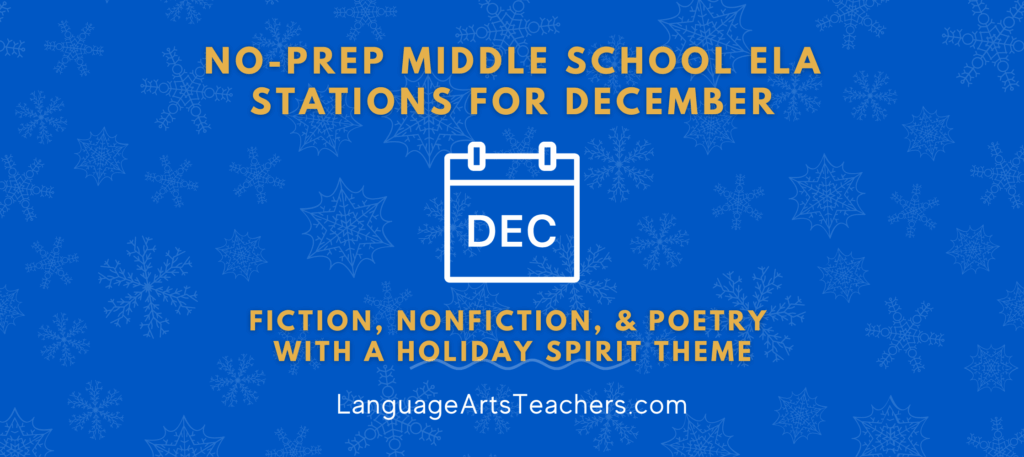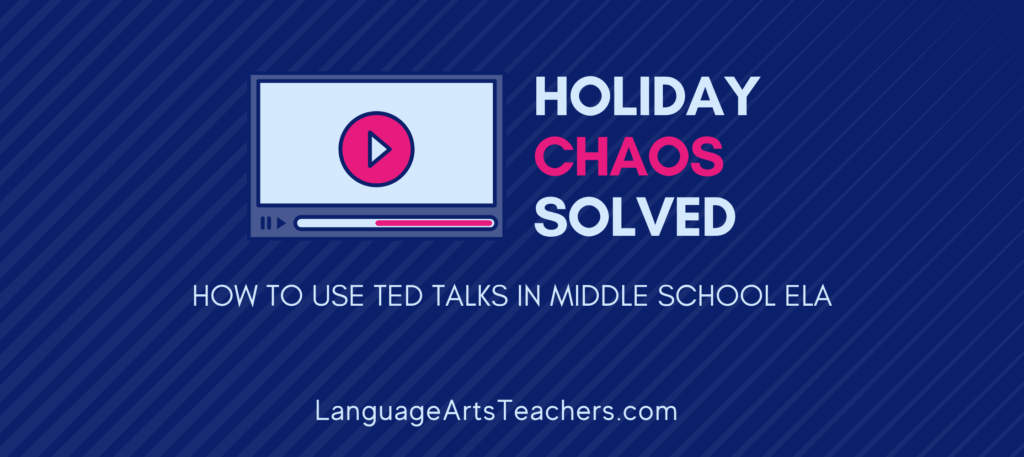End of School Year Activities PERFECT for Middle School ELA
Lessons & Activities for the End of the School Year
Problem:
Grades are done (or almost done) and while you really can’t take any more grades or you simply don’t need to, your students STILL need to be engaged every single day until the end!
Maybe you have a day or two left and you’re not sure what to do.
Or perhaps you’ve got a week to kill.
Two weeks left?
Three weeks? YIKES!!
Here are some excellent activities that are meaningful, relevant, creative, and challenging to keep your students engaged right up to the last day!
We’ll go in order with 5 activities, from the one that potentially takes the least amount of class time all the way to the one that takes the most (up to days and days’ worth!)
Option 1: Advice by Students for Students
Got just 15 minutes to fill on the last day? Or a whole class period you need to fill?
The “Advice by Students for Students” activity will solve either issue for you!
What it is:
Think of three to five open-ended questions your students can respond to that will show what they’ve learned AND that future students will benefit from.
Example:
“What do you wish you knew on Day 1 of this class that you now know?” Or maybe “Future students will do great in this class if they understand that _______________.”
Will you get some goofy, off-the-wall answers? You bet!
Will you get some “OMG that’s so not even true” answers from THAT kid?” Of course!
But you can pick and choose which responses you want to copy or use in a Prezi or a Power Point for the next school year and not worry about the others!
How you could spend as little as 15 minutes on it: Just have your students write for a set amount of time and then be done with it.
How you could stretch it to take a whole class: If you have several questions ready, give students one question at a time and give them a specific amount of time to write.
Then have them share their answers with each other (they typically love doing this!) and then let them proofread those answers to “get them ready” for next year’s students to see.
You could even have them get into groups, and then as a group decide on the best answer for each question and then they can re-write it as a group.
How to make this super easy for YOU: You’re not grading this stuff. Sure, someone will ask, “Is this for a grade?” but it doesn’t matter.
You can tell them they can’t go to lunch until it’s done, LOL!!! Or just tell them that of course it’s not for a grade—it’s for next year’s students!!!
Not everything in life is for a grade.
Sheesh, right?
Option 2: Writing a Legitimate Thank You Letter
Got a day or two?
This could potentially take up two full class periods because this involves a rough draft AND a final draft.
Thank you letter-writing is STILL a relevant skill, especially when coupled with the need to meet standards for relevant, informational writing.
It’s a perfect way to spend a couple days at the end of the school year because students will learn (or re-learn) the properties and elements of writing a letter: salutation, spacing, paragraph formation, closure, etc.
They’ll also learn the WHY behind taking the time and effort to write a thank you letter—a real thank you letter they can actually send to someone—even in today’s day and age (or especially in today’s day and age!)
What to do:
Take a few moments to engage your students in the feeling of gratitude and empathy and kindness (and how we need more of it!). Talk about how taking the time to genuinely thank someone is the greatest gift of all. Find a couple videos on YouTube that show the compassion and connection between people who show thanks. In other words, bring them into the assignment on an emotional level rather than simply saying, “We’re writing a thank you letter today” out of context.
How you could spend as little as one class period on it:
Walk students through the basic components of a thank you letter—the format, the paragraph structure, the salutation, etc. Then have students choose a person to thank. It could be a teacher, a relative, a friend, or even someone they’ve never actually met that still had an impact on them in some way.
How you could stretch it to take two class periods:
Show them how to address a letter!!! OMG they may have never done this before. And honestly, how often do we as adults actually have to address an envelope and mail it? But it won’t hurt them to learn! This could be quite an experience!
Also, you can have students further develop their thank you letters: proofreading, editing, peer revision, elaboration, the whole shebang.
How to make this super easy for YOU:
It’s not about the grade, so don’t turn this into a huge grading project for yourself.
You have wine to drink and family to hang out with this Friday!!
Instead, show your students that this about taking the time, effort, and patience to truly show gratitude by making the letter itself as clean and well-written as possible (as meaningful as possible for the recipient).
Option 3: Quotable Quotes Analysis & Creativity
Ever gaze at those super amazing quotes on Pinterest in starry-eyed wonderment?
What is it about a quote written in beautiful or unique letters and fonts that grabs our attention and makes us actually pause to reflect on the quote’s meaning?
Teach your students that sometimes the WAY words appear—the colors, the styles, the emphasis of words from bolding them or from italicizing them or capitalizing them (or not) conveys meaning.
Let your students question they WHY behind the artistic flair of how these creative quotes appear. In fact, change the size of certain words, or the placement of others, and is it possible to create a new meaning within the quote itself?
This is really engaging, higher-level, ultra-creative thinking for your students to participate in.
It’s like that saying: It’s not WHAT you say, it’s HOW you say it. This is the tone that writers and creatives are able to develop in their quotes, and it’s such a great way to teach, reteach, and have students analyze the power behind the words themselves in a visual way.
What to do:
Gather a few of your favorite Pinterest quotes (need ideas? I have a whole Pinterest board full of quotes perfect for the middle school ELA classroom). Show a few to your students. Talk about how the visual aspects of the words also carry meaning. Have them show YOU what they notice about the message from the colors, fonts, etc.).
How you could spend as little as one class period on it:
Show a few quotes, spend a few minutes talking about them and the visual aspect of the message, and then let students find their own quotes to re-create (markers, colored pencils, etc.) Post them around the room and have students use an index card to explain what they did to the quote and why (post the card with the artistic version of the quote).
How you could stretch it to take two class periods:
This could become a mini-research project.
Students might need time to find a meaningful quote, or, if they’ve been able to really dig into some amazing novels this school year, maybe you’ll want them to access a favorite of theirs and pull one powerful quote from it (what they consider powerful) and create their own version from that. It could take a whole class period for just this part.
For Day 2, students could write an analysis of why the quote they chose is powerful from the novel or short story, what it means in the larger context of the story, and why they created the quote in the way that they did).
Post the quotes and the analyses around the room, participate in a gallery walk, share ideas, let students informally present their quotes & analyses, and you can see how this could easily become a two-day activity.
How to make this super easy for YOU:
Again, there’s nothing difficult to grade here. You can glance at the finished quotes and glance at the analysis and you can quickly grade them holistically: 1, 2, 3, 4 (70, 80, 90, 100 for examples).
Grade them AFTER students have posted them on the wall so you can ensure YOU are not taking home anything!!!
Option 4: Ted Talk Analysis
Many schools totally frown on showing movies (unless it’s literally the last day of school and final exams are done and there’s literally nothing sane going on).
But what if your students are viewing relatively brief Ted Talks that really speak to them and that they find meaningful?
And what if those Ted Talks happen to tie in with ongoing standards that students need to develop and build on in Middle School ELA year after year?
Standards like speaking & listening, analyzing author’s purpose and his or her persuasive techniques…
So Ted Talks are perfect!
Getting the most out of a Ted Talk in the classroom, like where your STUDENTS are doing the work and you’re NOT, is going to require more than just showing them the Talk and then trying to get them to write about it or talk about it.
Plus, if your students are really analyzing a TT video the way they should in order to compare ideas and to critique the Talk itself, then they’ll probably need to view the Ted Talk more than once.
See how a 10-minute Ted Talk could actually be stretched to fill a whole class period?
Let’s break it down.
Ten minutes: students work collaboratively to review the elements of a really good, persuasive speech. Share ideas, jot them on a central place for all to see, fill in the gaps if students missed anything important.
Ten minutes: Show the video (assuming it’s a 10 minute Ted Talk… We’ll just say 10 minutes for the sake of keeping the numbers easy for now).
Review the elements of a good speech from earlier in class. This is the start of the discussion.
But wait! There’s more!
Now, pass out a little handout or recording sheet with open-ended questions related to the MESSAGE or AUTHOR’S PURPOSE in the Ted Talk.
Use questions like this, totally standards-based:
-
What central idea does the speaker want the audience to understand or to believe?
Watch the video again (there’s another 10 minutes!)
Now let students fill out the form as they re-watch the same Ted Talk.
Let them have you pause the video. If you’re in a 1:1 classroom, they could even pop in their earbuds and do this on their own (I’d watch it as a class first, then move to the 1:1 devices if you have this in your classroom).
Stop & Talk.
Take 10 more minutes for students to share their analytical responses from the handout. This could be a small group activity or a whole class one.
Finally, have students analyze the “speaking & listening” components of the Ted Talk. They don’t have to watch it again unless you think it’s important for them to do so, or unless they just need to for the questions.
For the speaking & listening component, consider using questions like this:
-
How does the speaker use his or her hands / gestures / movement on stage to emphasize or de-emphasize parts of the speech?



